The Handstand
NOTE: I wrote this tutorial about 6 years ago. 6 years. Needless to say, I use different methods in teaching the handstand today. Some are slight differences, some are dramatic. This tutorial will get you there, but for the latest in my training, head out to a seminar. Thank you.
The handstand – a fundamental skill if you are interested in bodyweight exercises. Working it will build strength and help develop total body coordination.
I’ll be throwing a lot of information at you in this post. Before you dive into this tutorial, I need to explain something. I’ll be describing the handstand piece by piece, so that you can better understand the form and technique. But when you train the skill, I want you to put those pieces together in your head. As I said, it’s an exercise in total body coordination. Do not get so focused on one part that you confuse yourself and neglect another part. Everything must work together. So read through everything first and try to get an overall sense of the skill.
Oh… and make sure to practice A LOT.
We’ll start with the “modern” handstand as a base to jump off. This is a straight handstand that is the standard in gymnastics these days. With your body in a straight line, this is also considered the “cleanest” looking handstand. I’ll describe variations as I get to them.
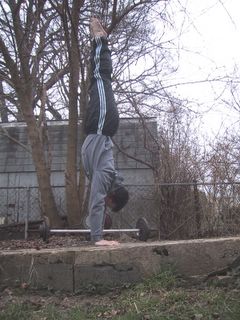
Let’s start from the top . . .
The feet

When you first start training, try to keep your toes pointed. Yes, this is mainly for aesthetics. You could still perform a handstand with hook feet, but I feel that when I straighten my toes it helps to line everything up. The feet point upwards; the body flows in that straight, upwards direction.
The legs

When you first begin, you will also find it easier to try and keep your legs straight and together. Keeping them straight will prevent them from flopping around like limp noodles, making things harder to control. Keeping them together will prevent them from flailing about as two different entities. You’ve got enough on your mind trying to coordinate the rest of your body. So help simplify things and keep those legs together for now!
The torso

The torso is one of the major components that will determine the look of your handstand. As far as your torso is concerned, a straighter handstand is achieved by slightly tensing the abs to keep your body in line. You will get handstands like this:
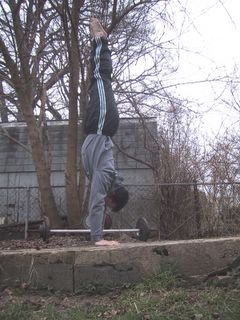 |
 |
If you were to relax your abs a bit, let your torso and legs fall towards your backside, and bring out your head (discussed below) then you’d wind up with handstands like this:
|
|
|
Gymnasts back in the day held handstands with this significant curve in their backs. For this reason, I’ll call this the “old” style handstand.
As gymnastics changed, the handstand was straightened out for both aesthetic and technical reasons. The modern form allows harder, more complicated gymnastic skills to be performed.
The shoulders
You’ll want to really extend and engage the shoulders. This muscular tension will give you greater control. Think of shrugging your shoulders upwards or trying to push into the floor. The difference looks like this:
.jpg)
unshrugged

shrugged

shrugged
The head and arms
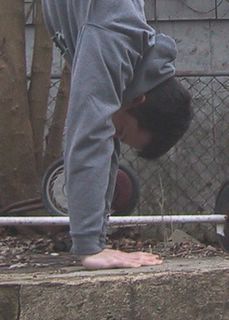
You’ll find your head position will be the single greatest factor affecting your back/handstand shape. Why is this? Because the spine follows the head. If you really pull your head out (to look at the ground), then your spine will follow suit and bend. This will give you that banana shape. Try and keep your head between your arms as much as you can. Instead of pulling your head out all the way out to stare at the ground, try to look upwards a bit with just your eyes. This will help to keep your head in and your back straight.
To those familiar with the Brazilian martial art known as Capoeira, the head is brought between the arms even more, so that a Capoeirista can watch his opponent, instead of the ground.
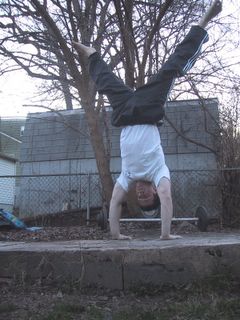 |
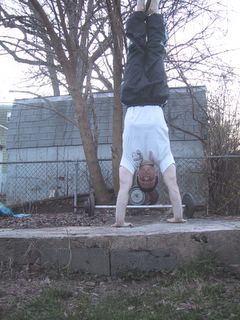 |
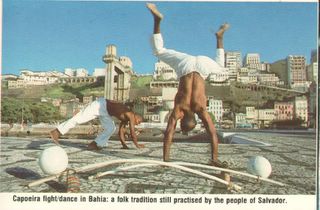
Two capoeiristas square off
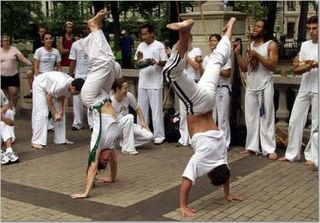

a neutral head position allows one to see their opponent.
So you’ve seen three styles of handstands – modern, old, and capoeira. You may be asking yourself “which is the best?” In the end, none are. They are simply different variations for different situations. Unless you’re in a Capoeira roda, or in front of Olympic judges, perform whichever one you want. I use each for different purposes myself.
That being said, I would still recommend that you learn all three. Each variation you try will help you better understand and control your handstand.
And as for the arms – straight and shoulder width apart for now. Not much else to say about them.
The Hands and Fingers
I place my hands on the ground like this:
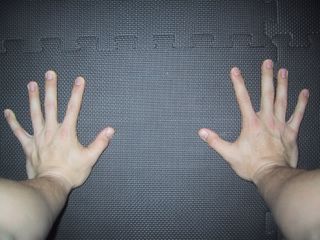
Keep your fingers spread out slightly and facing forwards. This is to allow for the greatest amount of control and stability in the handstand. The fingers are a huge part of controlling the handstand; something I’ll explain below.
Training
To start training for the handstand, get yourself a wall. You’ll be kicking up against the wall to get use to the handstand position. So put your hands down about a foot away from the wall and get your legs into the position shown below. It looks similar to a sprinter getting ready for the start of a race.
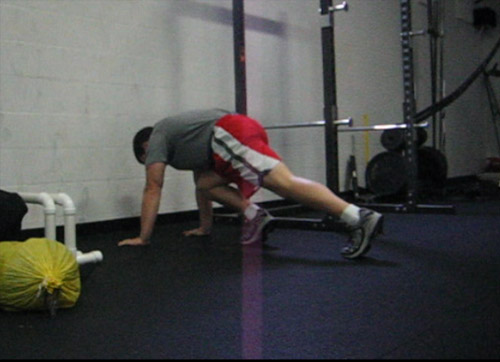
Now what you’re going to is take the leg that is straight and kick it up, heel first. Make sure to keep it straight, as this will generate more energy to lift your body up.
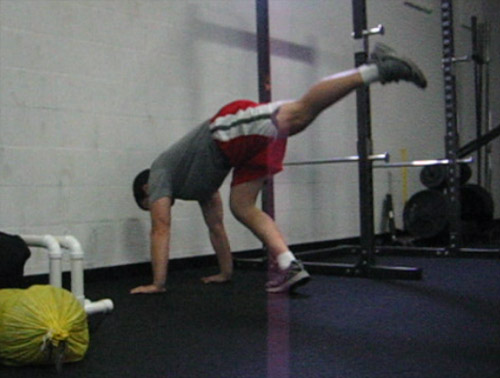
As your kicking leg goes up and over your head, the other leg that was bent should come up to join the kicking leg as both legs reach the wall. Try to do this so that your feet come to REST on the wall, not slam into it. This will start to teach you the right amount of force you need to kick up into a free standing handstand without kicking over.

Now that you’re in position, try to lightly tap your feet away from the wall into a free handstand. Like so:
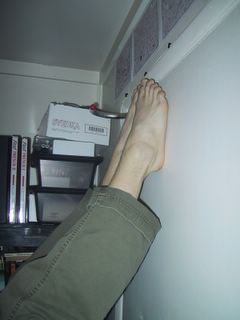
toes on the wall
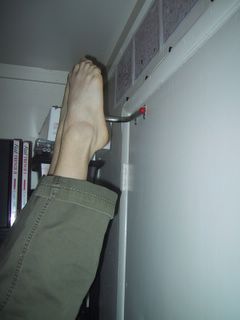
toes off the wall, holding a handstand
If you fall back down to your feet, simply kick back up and try again. If you fall towards your back, the wall will catch you. It’s like having training wheels. Your back might be a bit arched at the moment, but this is something that can be adjusted later. For the now, you’re trying to bring your feet away from the wall and balance the position.
An important thing to remember is to keep your weight on your hands somewhere around the top of your palms and your first knuckles. I’ve illustrated below the general area where you want to keep your weight centered.
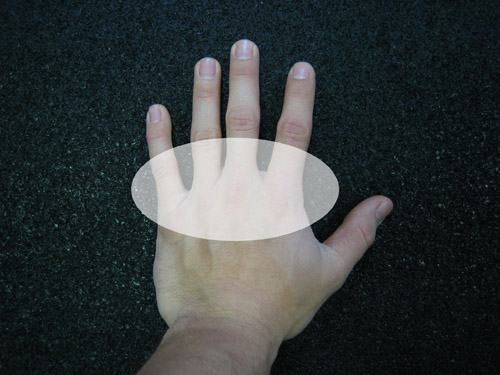
If you have to shift your balance at all, shift it towards your fingers (overbalancing). If you shift it to the heel of your hand (underbalancing), then you’ll often find you can’t shift the weight off the heel of the hand. The handstand will feel like it “died” and will become more difficult to control. If you overbalance though, then you can still control yourself.
This leads us into the primary way to keep balance – the fingers.
Like I mentioned before, your fingers are spread out to give you the most control. Here is where that control comes into play. With the handstand, you are most unstable in one plane – front and back. When you start to feel like you are leaning towards your back (overbalancing), you should press your fingers into the ground and bring yourself back to the balance point described above.
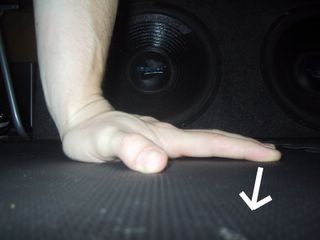
Now your fingers don’t do all the work. Remember how I discussed keeping your toes straight, your legs together, and your abs tensed? Well, all this comes together now as you try to balance yourself. If you keep your body under a bit of tension, then your fingers can move this single unit back into a balanced position. If you let everything relax, then it’s like trying to stand cooked spaghetti on its end.
Continue tapping away from the wall in this manner until you’ve got a sense of how to correctly balance yourself. As I said, fingers play a huge role in balancing, but don’t forget your legs and midsection to help as well.
Away from the wall
Feeling good so far? Well then get the heck away from the wall! The sooner you drop the “training wheels” the sooner you can develop a solid handstand.
For your first couple (read:hundred) handstands, you’ll want to find a relatively open area where you can land safely without kicking something.
Ready? Do you remember how hard you need to kick? Well then, get into the previously described kicking position and get yourself inverted. If you haven’t fallen over yet then try to keep yourself upside-down for as long as you can. Feel free to walk around a bit if you need to get your balance.

If you’re walking around, your legs may split a bit, your back will probably be arching, and the whole thing in general will look ugly, but you’re in a handstand, and that’s what matters. Fighting to stay up as long as possible will help build up the strength and balance that you need.
If something goes wrong
Other than “falling into a heap”, there are two ways you’ll be getting out of a handstand when you start to fall towards your backside – the roll and the pirouette.
The roll is simply a matter of tucking your chin to your chest, bending your arms slowly, coming down on your UPPER BACK and rolling forward. Please don’t piledrive your head into the ground. It’s just a simple forward roll out of danger.

When you start off, you’ll probably only want to do this where the ground is soft (a lawn) and where you have a bit of space (a lawn).
The second technique is the one I prefer – the pirouette. Here, you’ll keep your arms straight throughout and turn your body 90 degrees out of danger. In this picture, I was in a handstand, and began to fall to my backside (the right of the photo).

Now imagine your hands are trying to turn a steering wheel 90 degrees, and turn your body off to the side. And just like you see in the picture, you’ll land on your feet, facing your hands. Is this move really that difficult? I don’t believe so. I hope I’m not confusing anyone or glossing over the topic. I think it’ll make sense to you when you start training.
Both these techniques are greatly preferred over slamming into the ground with a flat back, or trying to put your feet down and landing into a bridge. Trust me.
Saving the handstand
Now if controlling a handstand was like driving a car, the finger pressing and ab tensing, etc, would be the normal turns and micro-adjustments we make during a ride. The techniques below would be analogous to violently jerking the wheel from side to side.
Don’t even read this section until you’re handstand is starting to shape up into something you can work with. This is nothing you’re going to use regularly as your handstand gets solid, but I figure it’s useful to know when you are fighting to stay up.
First is a technique to save a handstand that’s falling to your feet (underbalanced). It’s a quick bend of the arms that will dip your shoulders and bodyweight forwards a bit, in hopes of saving things.

Please, oh please do not plow your face into the ground. If you don’t feel like your arms and shoulders can handle the load, then don’t do this. Just fall back to your feet and be no worse the wear.
This next technique is for when you begin to fall towards your backside. By quickly flexing and bending at the waist, you can hopefully shift your bodyweight back over your hands and save yourself.
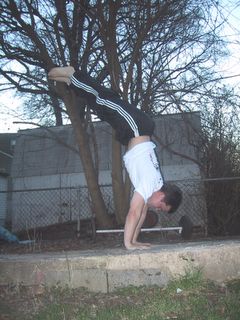
Both techniques, as you can see, involve a rapid shift in bodyweight. You’ll want to develop a good handstand where you won’t need to do any of this violent wobbling around. But it’s always good to keep in the back of your mind, should the need arise.
So there you are folks, the handstand…



.jpg)
Let me know if something is unclear. For such a fundamental technique, I want everyone to understand and learn the skill. Best of luck with your training.



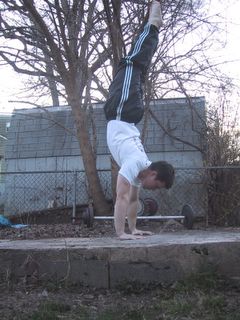
I’ve seen several ways of doing this and the most consistent and stable I’ve seen is of you and a bboy named tales. I wonder if you could recommend some pre-handstand attempt workouts or stretches since I’ve been able to do the handstand on the wall for abouve 4 months now and am still only able to push off the wall for a maximum of maybe 4 seconds because I come down because of momentum or I go back to the wall. I know it has to do with familiarity and I try to do this wall stand at least 3-4mins a day every day.
I have had wrist and shoulder injuries from ages ago which I guess make me a little weaker, but are there any strengthening or stretching exercises you would highly recommend that are pertinent to achieving a handstand or should one just jump into the exercises you’ve given from step 1 upwards?
Thanks for the site it’s been a quality find.
Check out a book by Paul Wade (which Jim Bathurst models the exercises in). He has some exercises you might find helpful.
Bernard,
I have so much to add to this tutorial. I will update it in the future. For now, stretch the wrists in all directions and practice the crow pose (a yoga position). This will help tremendously.
-Jim
Hey Jim, what’s your thought on spreading legs a bit apart? Personally I found that it helps me to not tip over.
Bill,
Do you mean scissoring your legs (spread front to back) or straddle (spread out to the side)? Both can lower your center of gravity and make the balancing easier.
In my most recent handstand progressions that I’ve been using with athletes, I will have them scissor first.
-Jim
I’ve got some free time the next 5 weeks, and will be practicing handstands from scratch :) I’m looking forward to updates to your tutorial.
Thanks for this guide! I’m in a similar situation to Bernard, and I’m gonna try that crow pose and keep checking back here regularly! You rock man!
Hi, and thanks for a great site. I’m not so much for training in gyms etc, but training with the body weight is often both rewarding and fun. Will give this a try tomorrow already!
I like to add to suggest your readers/students to try stomach-to-wall for the wall handstand. It offers a ‘different’ challenge to back-facing-wall handstand.
Lloyd,
I agree. I’ve been using the stomach to wall variation over the past year with great results. I have not updated the tutorial, but I teach the handstand a bit differently now.
Excellent tutorial – new site layout looks great!
Personally I like walking the hands back – belly to wall styly, I find it’s good for developing the ol’ shoulders, tris, abs &c.
Thanks again.
Yes. As I’ve mentioned, I’ve been using this technique with great results with myself and athletes.
As for strengthening you may wish to incorporate:
Barbell shrugs
Dumbbell press
Tricep extensions
This will higher your center of gravity and make it easier to stabilize your shoulders next your head.
Just working the handstand itself will also help tremendously!
Hi,
When I do the handstand, I get all the blood rushing to my head and I can’t hold it for more than 20 seconds (max). Do you have any tips on how to manage this?
Thanks!
Make sure to breath!! We too often hold our breath. I am able to talk normally while upside-down in a handstand, because I am breathing at a normal rate. This takes practice. You can practice counting upwards as you hold your handstand and see if you’re able to maintain your breath. Good luck!
Hi,
Your post is truly useful to me. I have been practicing all the year my handstand, i practically can’t fall, i can walk between walls, i can turn 360° while in handstand, i have a worked superior body and i can bend up to 30° my elbows. BUT…i never, never can stand in the same place without moving my hands for more than 5 secs; after 10 seconds of doing it my head is plenty of blood(i practiced also against a wall but is the same); i always need to look at the ground, if not i start moving everywere, up to force my self to finish the handstand. My head in that position just make all my body to be extended like a banana(even forcing me to bend my knees). What can i do to stay longer(bloody head) and all in the same place? Thank you!
I will be writing an updated version of this tutorial. Until then, look to get yourself up against the wall with stomach facing. This will keep you in a straighter line, as the wall will let you know when you are “banana-ing”. For the blood to the head, breath!! Many do not breath well and tense up their face in neck when upside-down.
Yeah, i hiperextend my spine in the search for the stability, because as i extend my neck to look at the ground (it’s bad), as you said, i extend my neck and my body follow that movement.
I ‘ve just done it again but this time looking a bit more anterior ground and MAN YOU ARE A GENIUS, i done it, i made it! At least one time jejej. Thank you very much, i will try to improve it more and more as i practice more the posture of my neck. THANK YOU!
Great tutorial. This is what I’ve been looking for to really take my fitness to the next level.
Thank you so much for this awesome tutorial! :)
I saw this page before but it has been a while i haven’t read it again, and i can tell now that i am making good progress, i can relate and understand things you wrote i read before but could not grasp yet.
Dude pretty good tutorial but when’s the update coming?The page also links you to the ‘seminars’ section but you’ve got none planned, so come on update this page.
JIM, ur doing a great job, its really & really apreciate u.
i do hs for several minutes with wall suport for the last 6 monhts more. i could not succeed in open ground (without support), kindly please advice me some ideas to this on ground without a support. thnks a lot
Hi.
this site is great. i think i have developed a good handstand, all thanks to you jim, but i wanted to know, i like weight excercises too and i cant find a good routine which i can practice both with the correct amount of muscle rest. im working on the planche but im afraid to lesson my shoulders due to overwork. what could i do in this situation. i would appreciate your help. thanks.
Hey Jim,
I really admire your work. I was able to do my first back lever because of your tutorial :)
Can you give me a few tips with the handstand ?
– I’ve been working on the handstand for 6 months
– I have mastered wall handstand for 60+ seconds
– I have learned to do a frog stand (crow pose) for 60 seconds
– I can do several handstand push ups against a wall
BUT I cannot maintain my handstand :(
I either kick too much or not enough. Sometimes I can hold it for a second or two but I always end up falling… Please e-mail me so I can share more information, I really want to learn ALL the bodyweight skills.
Thanks for the help ! :)
Hey Jim,
I have difficulty balancing the handstand, could you help ?
– I have been practicing for 6 months
– I have mastered the wall handstand for 60+ seconds
– I have learned the frog stand and can hold it for about 60 seconds as well
BUT I always fall when doing a handstand. Either to my back side or I don’t kick hard enough. Could you give me a few tips to improve my kicking and balansing because I sometimes get into the handstand and balance it for 2-3 seconds but then I fall forward.
Thanks !
It’s been about 8 months since I first started doing basic headstands. Five months ago I intiated handstand practice; and approximately 6 weeks ago, hand-walking found its way into my repertoire. I look forward to developing my abilities more as well meeting new challenges. To all who express genuine curiosity and determination when exploring limits: keep going!
Hello!
That’s a very nice tutorial you have here and it has helped me a lot. I’ve been progressing in calisthenics with the Convict Conditioning method and that’s how I got to know your site.
About the handstand.. I’ve been training for some months now and I can perform 8-10 half handstand pushups (2 seconds down, 1 second at the bottom and 2 seconds up) or 20 if done faster, but I’m struggling to hold a free handstand. When I tap away from the wall I slowly fall backwards. It’s been some months and even though I feel stronger shoulders and arms because of the half HSPU’s, I feel I haven’t progressed at all in balancing a free handstand.
Do you have any hints? Thanks in advance!
Any update on the tutorial as yet?
Great tutorial, Jim !
What is the average time to master the handstand ? :)
At school I do my handstands for 3 1/2 seconds and I just can’t seem to get my balance right. I’ve been trying this for like 2 days and I go to acrobat and started yesterday for the the first time. I just don’t get how to get your balance.
Hey,
Saw your post and thought it was great. Love how you broke every component up and focused on each part.
Just one query, where should your hear be facing? I can’t help but keep looking where my back faces. This kinda makes my head tilt back and lose balance.
Ta
Hey that was very helpful, thank you! But im having a bit of a lower back pain when i try my handstand next to the wall, is that normal??
My Problem is struggling to kick up hard enough to make it, i also to to bend my leg as soon as i get up, any tips please
Get coached! Hard to describe everything to do here.
how do you land?!?!
I have one problem with press up hold position,but when I be in position I hold it 35s . How I make better press up??
I am sorry for my English.
Hi,
I am a practicing capoeira since one year now and have a ‘not too bad handstand’ that I can perform from many startings points (jumps, catwheels, ground movements, etc), and I can keep on handstand position for few seconds (up to 10 secs).
However, I still need to do a lot of small steps with my hands to keep my handstand or will have to fall in a more or less elegant style ;)
So, I would have two questions:
1/ How to avoid those unaesthetic small steps? Any exercise to improve this particular weakness?
2/ I would like to spread my both legs on the back, which is another stength based capoeira movement by arching my back, what would be your advises to prepare that kind of movements?
To provide a feedback on my path in handstanding, the most important thing from my point of view is to keep training consistently, you will see real improvement quickly if you train it daily (ideally) or at least 3-4 times a week.
I noticed that training it from a cartwheel or little jump help to measure the quantity of power you need to get the handstand position from different initial situations. I also train a lot from a ‘frog position’ maybe because I am French, but it helps a lot to build your confidence in your body at the begining and it is way easier to control as well.
Cheer,
Clem
Hey first of all I wanted to thank you for this great site!
Now I’ve got a problem with the handstand. When I’m leaning against the wall, I just can’t keep my weight on the area you’ve illustrated above! It feels like the whole weight is right under my arm and my hands always lift off the inner side. I’ve tried to focus on keeping the weight where it’s supposed to be but somehow I can’t do it right now. Have you got any ideas how to improve it?
Oh and sorry for any misspelling or bad language. I’m from Germany ;-)
Sounds like your elbows may be flaring out to the side. Extend those elbows strong and keep the hands down!
I’ve been practicing handstands for a couple of years for capoeira but still having trouble maintaining it upright for more than a few seconds. Half the problem is a very flexible back that means it’s too easy to flop over into a bridge. This is a great tutorial and I’ll amend my technique but the only thing I really can’t do is put my weight on the right bit of my hand, it just rests on the heals and fingers leaving a space at the part you’ve recommended. Any idea how to sort that out? Thanks
Work hollow body positional drills to improve the midsection control, work the crow pose to work out the balance on the hands. Good luck!
Ive been doing the straight handstand for 15 weeks and can only hold it 2-3 seconds and that’s only sometimes. But im trying for straight handstands. If i switch to curved handstand will i make progress faster because its easier? and if i do and get good at curved hadnstand will it take very long to get a straight handstand? or should i just keep going super slow progress with the straight handstand.
Great tutorial here. When can we expect the updated one you mentioned? Even a few one-liners in a blog post might be helpful.
I’m 39 and I’ve been trying to master the handstand for the first time. Now I can kick up against a wall and hold there for up to about 20 seconds. Progress has been slow. My problem is a restricted shoulder range that doesn’t let me get 180 degrees of flexion in my left side – more like 150-160 degrees. Do you have any ideas on how to cope with this or improve it?
Thanks a lot!
I have an issue with the handstand in that, when I’m inverted, too much blood rushes to my head and makes me dizzy. It’s not only very annoying, but is slightly painful too. Is there any way around this, or is it an issue with blood pressure?
Thanks
Breath, hold for less time until it starts feeling more comfortable.
What do you recommend for increasing your planche ability and transferring into a handstand from there? I have done a single rep on bars before but from the floor it seems to be more difficult. I have the strength and am capable of doing handstands, handstand walks, handstand push ups, and holding the lower position of the planche. I want to eventually be able to do horizontal push ups without feet and be able to transfer into the handstand to finish with a few reps of handstand push ups.
Smearsmell on Youtube has an excellent, yet simple planche tutorial. You can see a press from planche to handstand at the end. Check it out!
Astrologie noire taureau mon avenir par les cartes